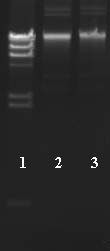RIGHT-CLICK 4× DNA LIGATION MIXTM

1.
Lambda DNA HindIII digested before reaction
2.
Same after 5 min of ligation
3.
Same after 10 min of ligation
10 µl of each sample on 1% agarose gel
Same pattern was observed after purification and redigestion of ligated DNA.
Cat.# B 0014 Price: £80.00
Pack size: 50 reactions
Storage: -20 °C (3 months), +4 °C (3 weeks)
Description: The RightClick 4× DNA Ligation MixTM is designed for fast and efficient ligation of cohesive and blunt-end DNA fragments at room temperature.
Applications: DNA fragment cloning , vector recircularization, linker ligation.
Content:
Right-Click DNA Ligase 50 µl
4x Right-Click Ligation Buffer 250 µl
DNA Dilution Buffer (Tris-Cl 10 mM, EDTA 0.1 mM, pH7.8) 500 µl
Right-Click DNA Ligase – T4 DNA Ligase at optimised concentration.
4x Right-Click Ligation Buffer – Mix containing Mg2+, ATP, Tris-buffer, and additives.
Note: Mix thoroughly before use. Avoid multiple freeze/thaw cycles.
Quality Controls:
- Lambda DNA samples (100 ng each) were cut with EcoRV (blunt), and Hind III (cohesive), and then religated into fragments bigger than 12kb and 25kb respectively. Time needed for that was less than 20 min and 5 min respectively.
- Loss of transformation efficiency comparing with classic 16h at +4°C ligation was no more than 20%.
Shipping: Any temperature equal or below ambient.
Product use and limitation:
Usage
Length of DNA fragments
2kb – 6kb
6kb – 10kb
>10kb
sticky
blunt
sticky
blunt
sticky
blunt
Maximum amount to be ligated
100 ng
100 ng
150 ng
150 ng
200 ng
200 ng
Time needed for DNA ligation by 90%
5 min
20 min
10 min
40 min
20 min
60 min
Maximum value for vector/insert ratio*
1/5
1/10
1/10
1/20
1/20
1/50
Maximum duration of reaction before it will reduce consequent transformation efficiency**
1 h
1 h
1 h* Data is obtained for ligation of fragments that were cloned before and are used for recloning procedures. We recommend increasing the number of inserts by up to 10 times when PCR products are involved in reaction.
**Efficiency of transformation usually decreases if the reaction is longer than 1 h.
Dephosphorylation of vector is advised in case of blunt-end ligation (1u of CIAP per 100-500 ng of DNA, 20 min at 37 ºC, 20 min at 80 ºC, following purification with DNA purification kit or with Phenol/Chloroform is optional but recommended).
RIGHT-CLICK 4× DNA LIGATION PROTOCOL
- Estimate number of reactions (N): do not forget to include control ligations. Final volume of one reaction is 20 µl.
- Preparation of 4× Ligation Mix: take N µl of Ligase and 5× N µl of Ligation Buffer, mix thoroughly by pipetting. We recommend using freshly prepared 4× Mix, it can be also stored at +4ºC for up to 3 days.
- Take 5 µl of 4× Mix in a 1.5 ml sterile Eppendorf tube at room temperature, add 15 µl of DNA solution containing vector and insert with gentle up/down pipetting up to 20 times. Do not allow bubbling.
- Leave for suggested time (see Usage Tips). Allow more time if more DNA is used in reaction than advised. Do not exceed 1h.
- Optional step: preheating for 20 min at 65 ºC. It does not affect results of ligation or following transformation.
- Take 2 µl of reaction mix for control electrophoresis (highly recommended).
- Add 100 µl of competent cells, proceed to transformation procedure according to the protocol from your supplier of competent cells.
- Run agarose electrophoresis with 2 µl of all control and experimental reactions.
Typical scheme of ligation procedure:
Experiment reaction
Control 1
Control 2
Control 3
Control 4 (optional)
Vector X µl
Vector X µl
Vector X µl
---
---
Insert Y µl
---
Insert Y µl
Insert Y µl
---
4×Mix 5 µl
4× Mix 5 µl
---
4× Mix 5 µl
---
ddH2O up to 20µl
ddH2O up to 20µl
ddH2O up to 20µl
ddH2O up to 20µl
ddH2O 20µl
If vector was dephosphorylated, we advise you to do a control transformation with same amount of vector before phosphorylation.
TROUBLESHOOTING
1. No colonies:
Check antibiotic;
Reaction is inhibited by DNA impurities – purify DNA;
Vector is degraded or damaged (often after over-dephosphorylation) – run electrophoresis;
Vector or DNA are toxic for cells – review strategy for cloning;
Competent cells are dead – use another stock or fresh competent cells;
Amount of vector is low – add more vector DNA.
- Background (number of non-recombinant colonies) is high:
- Vector is not fully digested or needs dephosphorylation – digest vector again and dephosphorylated, purify;
- Concentration of insert is low - increase amount of insert DNA in reaction;
- Competent cells are contaminated – use reliable stock of cells;
- Antibiotic level is low – prepare fresh plates or/and increase antibiotic concentration.